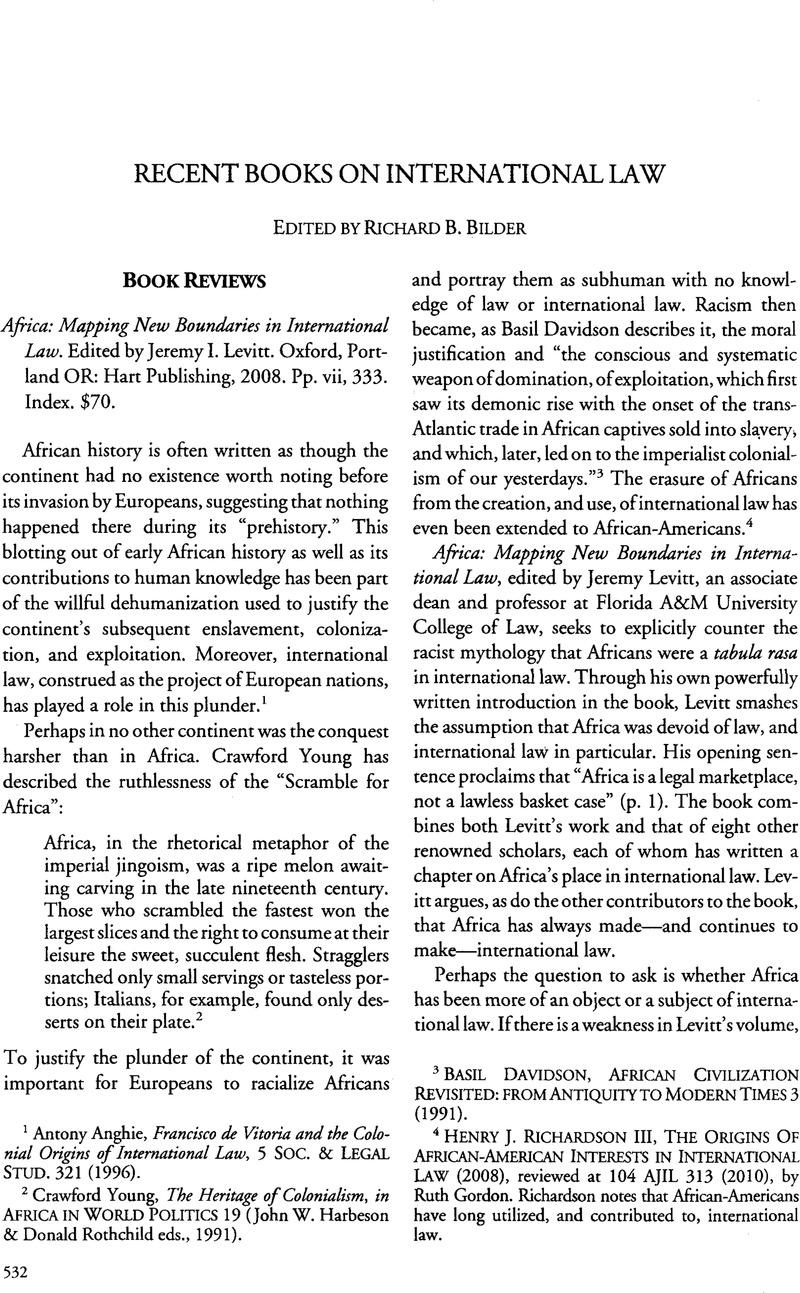No CrossRef data available.
Article contents
Africa: Mapping New Boundaries in International Law. By Jeremy I. Levitt. Oxford, Portland OR: Hart Publishing, 2008. pp. vii 333. Index. $70.
Published online by Cambridge University Press: 27 February 2017
Abstract

- Type
- Recent Books on International Law
- Information
- Copyright
- Copyright © American Society of International Law 2010
References
1 Anghie, Antony Francisco de Vitoria and the Colonial Origins of International Law, 5 Soc. & Legal Stud. 321 (1996)CrossRefGoogle Scholar.
2 Young, Crawford The Heritage of Colonialism, in Africa in World Politics 19 (Harbeson, John W. & Rothchild, Donald eds., 1991)Google Scholar.
3 Basil, Davidson African Civilization Revisited: from Antiquity to Modern Times 3 (1991)Google Scholar.
4 Ricfiardson, Henry J. III The Origins of African–American Interests in International Law (2008)Google Scholar, reviewed at 104 AJIL 313 (2010), by Ruth Gordon. Richardson notes that African–Americans have long utilized, and contributed to, international law.
5 Thérien, Jean–Philippe Beyond the North–South Divide: The Two Tales of World Poverty, 20 Third World Q. 723–42 (1999)CrossRefGoogle Scholar.
6 Gathii, James Thuo International Law and Eurocentricity, 9 Eur. J. Int’l L. 184 (1998)CrossRefGoogle Scholar (book review).
7 Sinha, Surya Prakash Legal Polycentricity and International Law (1996)Google Scholar; Siba, N’zatioula Grovogui Sovereigns, Quasi Sovereigns, and Africans: race and Selfdetermination in International Law (1996)Google Scholar.
8 Anghie, Antony Finding the Peripheries: Sovereignty and Colonialism in Nineteenth–Century International Law, 40 Harv. Int’l. L.J. 1 (1999)Google Scholar.
9 Bedjaoui, Mohammed Towards a New International Economic Order (1979)Google Scholar.
10 Mutua, Makau wa Why Redraw the Map of Africa: A Moral and Legal Inquiry, 16 Mich. J. Int’l L. 1113 (1995)Google Scholar.
11 The British, for example, regarded international law as the province of “Christian nations.” Crawford, James The Criteria for Statehood in International Law, 1976–1977 Brit. Y.B. Int’l L. 93, 98 Google Scholar (citing 1 Herbert Arthur Smith, Great Britain and the Law of Nations 12 (1932)).
12 Umozurike, U. O. Introduction to International law 9–10 (1993)Google Scholar.
13 Ian, Brownlie African Boundaries: a Legal and Diplomatic Encyclopedia 775 (1979)Google Scholar.
14 Oliver, Roland the African Experience 145 (1991)Google Scholar.
15 Id. at 145–58; Basil Davidson, Africa in History: Themes and Outlines 141–83 (rev. ed. 1992) [hereinafter Davidson, Africa in History]; Basil Davidson, the Lost Cities of Africa (1987); Cheikh Anta Dlop, Precolonial Black Africa: a Comparative Study of the political and Social Systems of Europe and Black Africa, From Antiquity to the Formation of Modern States (Harold Salemson trans., 1987); T. Olawale Elias, Government and Politics In Africa 1–12 (1963).
16 Davidson, supra note 3, at 77–124.
17 Elias, supra note 15, at 6–15.
18 Elias, T. O. Africa and the Developmen of International Law 11 n.25 (Richard, Akinjide ed., 1988)Google Scholar.
19 Davidson, Africa in History, supra note 15, at xxii–xxiii.
20 Bernal, Martin Black Athena: the Afroasiatic Roots of Classical Civilization (Vol. I (1987), Vol. II (1991), Vol. III, (2006)Google Scholar). For a critique of Bernal’s thesis, see Black Athena Revisited (Mary R. Lefkowitz & Guy MacLean Rogers eds., 1996).
21 Davidson, Africa in History, supra note 15, at xxii.
22 Shropshire, Denys W. T. The Church and Primitive Peoples: the Religious Institutions and Beliefs of the Southern Bantu And Their Bearing on the Problems of the Christian Missionary xix (1938)Google Scholar. Many Europeans believed in the innate inferiority of Africans. One European missionary wrote that “[t]he mere possession on the part of the Bantu of nothing but an oral tradition of culture creates a chasm between the Native ‘mind’ and that of civilized man, and of itself would account for a lack of balance and proportion in the triple psychological function of feeling, thinking and acting, implying that thinking is the weakest of the three and that feeling is the most dominant.” Id.
23 Barrow, Alfred Henry Fifty Years in Western Africa: Being A Record of the Work of the West Indian Church on the Banks of the Rio Pongo 29 (1900)Google Scholar.
24 Protocol to the African Charter on Human and Peoples’ Rights on the Rights of Women in Africa, July 11, 2003, OAU Doc. CAB/LEG/66.6 (entered into force Nov. 25, 2005) [hereinafter Women’s Protocol], available at http://www.achpr.org/english/_info/women_en.html.
25 Id, An. 14.2(c).
26 Id., Art. 5.
27 African Charter on Human and Peoples’ Rights, June 27, 1981, OAU Doc. CAB/LEG/67/3 rev. 5, 21 ILM 58 (1982) [hereinafter African Charter].
28 Mutua, Makau wa The Banjul Charter and the African Cultural Fingerprint: An Evaluation of the Language of Duties, 35 Va. J. Int’l. L. 339, 340 n.4 (1995)Google Scholar.
29 Guiding Principles on Internal Displacement, UN Doc. E/CN.4/1998/53/Add.2 [hereinafter Guiding Principles].
30 Mutua, Makau Standard Setting in Human Rights: Critique and Prognosis, 29 Hum. Rts. Q. 547 (2007)CrossRefGoogle Scholar.
31 OAU Convention Governing the Specific Aspects of Refugee Problems in Africa, Sept. 10, 1969, 1001 UNTS 45 (entered into force June 20, 1974).
32 Mutua, Makau Kenya’s Quest for Democracy: Taming Leviathan 247 (2008)Google Scholar.




